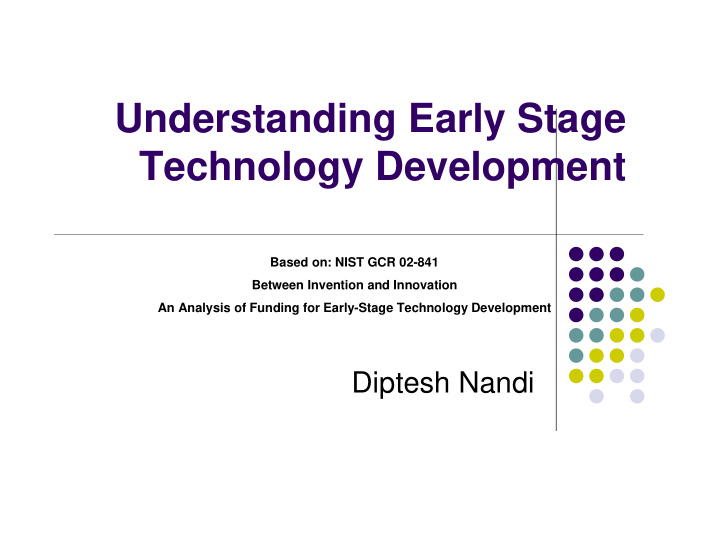



Understanding Early Stage Technology Development Based on: NIST GCR 02-841 Between Invention and Innovation An Analysis of Funding for Early-Stage Technology Development Diptesh Nandi
Economic nature and value of technology based innovations Technology based innovation Vs Incremental product enhancement Technology based innovation Higher novelty of scientific involvement Able to create newer markets Higher technical and financial risks Incremental product enhancement Companies with successful products have it easier Strengthen existing markets
The Early Stage Defining the “Early Stage” Seed financing Small amount of capital provided to an inventor to prove a concept Proof of principle: the project team has demonstrated the ability of the possible commercial product in a research setting Reduction to practice: a working model of the product within a range of specifications Startup financing Funds the product development and initial marketing phases
The Early Stage Startup financing For companies just organizing their resources and marketing plans Haven't started selling their products Assembled management, business plans and market research reports First Stage financing Provides funds to companies that have exhausted their initial capital and needs funds to initiate commercial manufacturing and sales
Sequential Mode of Development and Funding patent Invention functional Business validation innovation Viable business Early-stage Basic Proof of Technology Product Production/ Research concept Development Development Marketing (ESTD) Angel Investors Corporate Corporate Corporations Venture Venture funds, Research Technology labs capital Equity, SBIR Phase I SBIR Phase II Commercial debt Source frequently funds this technology stage Source occasionally funds this technology stage
Early Stage Technology Development (Stage 3) Third Stage Product specs demonstrated Production processes defined Businesses validated Capital for initial production and marketing Fourth Stage Product has been introduced in the market Innovation has taken place Fifth Stage Investors expect to see returns
Valley of Death at Stage 3 Valley of Death, the capital gap affecting the early stage transition from invention to innovation. “ when the amount of money you are asking for-the bill- starts to add up to the point where the management says, ‘what are you guys up to, what are you doing, and what am I gong to get out of it?’ But yet it is sufficiently early in the process that you don’t feel you can answer the question. If you are fortunate enough that the questions come when you have an answer, you, in fact, have scooted over the Valley. If not you are squarely in the Valley ” (Gerald Adolph, Booz Allen & Hamilton)
3 elements for the Valley of Death Motivation for Research Innovation is only the start Commercial Viability involves substantial amount of difficult and potentially costly research involving years sometimes Disjuncture between technologists and business manager Different points for success, failure and expectations Sources of financing Easily available research funds ( corporate research ) and Investment funds for prototype design In-between there is a capital gap for aspiring investors
Infrastructure and complementary Assets Large infrastructural requirements Gas stations for Internal Combustion automobiles Electric power plants for the electric engines Complementary Assets Supply of newer materials Supply of spare parts Training in the use of technology Supply chains Newer web based technology/software to augment performance
Value Capture “Understanding the mechanism by which value will be not only created but captured for a invention to become successful commercially is a necessary component of a business system.” “Value is a ratio of opportunity over risk” “Capturing value becomes important because of the faster technology development cycles, the time taken for a technology based innovation to go out of the market is directly linked with any future development of technology in that field.”
Funding institutions Corporations Bell Labs, IBM, GE, Intel Internal Corporate innovations Very few companies could follow this model of an in-house research lab for all future innovations “Excubating” innovations: outsourcing innovations through contracts and partnerships Corporate venture capital: partnership with the individual who wants to leave and start his own business
Funding institutions Venture Capital Provide funds in an iterative manner Seed investments tracked using milestone programs VCs tend to be closely associated with the Innovator The average company deal $15 million Modest contributor for the ESTD stage Helps the nascent enterprise into a business with strong prospects Prime motivation is to sell the business in the future
Funding institutions Angel Investors Wealthy individuals looking at high risk and high gain prospects Lack the due diligence required to take a much more closer involvement Universities State Programs Federal Funding
Thank you Questions
Recommend
More recommend